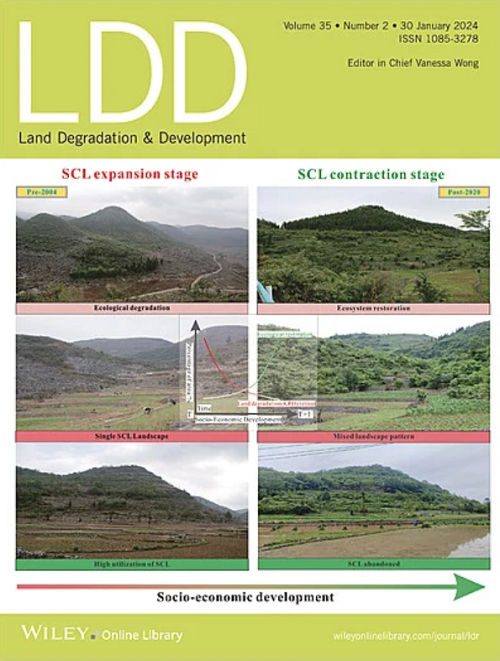Impact of Slope Cutoff Factor on Soil Erosion Estimates: A Hilltop Mine-Based Comparative Geospatial Study
IF 3.6
2区 农林科学
Q2 ENVIRONMENTAL SCIENCES
引用次数: 0
Abstract
The task of soil erosion estimation received a significant push by integrating remote sensing and geographical information systems (GIS) with the Revised Universal Soil Loss Equation (RUSLE) in the early 1990s due to its ease of applicability. The Topographic (LS) factor played a quintessential role in soil loss determination, especially for undulating regions. In most worldwide soil erosion studies, the topographic factor extracted from the Digital Elevation Model (DEM) using “LS equations” failed to account for the varying slopes before the material joins a stream or a river. In this study, the slope length (L) and slope steepness factor (S) derived without and with the slope cutoff factor are compared and analyzed for a hilltop mine. The results reflect that the LS factor and, ultimately, soil erosion are over-estimated owing to the absence of any limits on the slope length (L) factor in undulating terrains when used conventionally in a GIS environment. The mean soil erosion estimated with slope cutoff factor is 252.26 ton ha−1 year−1, whereas 332.81 ton ha−1 year−1 in the conventional application of the same LS equation. The overestimation of soil erosion was reduced by 35% as per the volume-based validation study. Thus, the study proves the usefulness of the slope cutoff factor, which, to date, has mostly been neglected in soil loss research and soil erosion studies for undulating terrains. The pattern of soil erosion also highlights the negating impact of vegetation on steep slopes, cementing their role as Nature based Solution (NbS) for soil erosion by dynamic landscapes like Mines.坡面截断因子对土壤侵蚀估算的影响:基于山顶矿山的比较地理空间研究
20世纪90年代初,将遥感和地理信息系统(GIS)与修订的通用土壤流失方程(RUSLE)相结合,由于其易于应用,土壤侵蚀估算工作得到了重大推动。地形因子(LS)在土壤流失量的确定中起着典型的作用,特别是在起伏地区。在世界范围内的大多数土壤侵蚀研究中,使用“LS方程”从数字高程模型(DEM)中提取的地形因子未能考虑到物质加入溪流或河流之前的坡度变化。本文对某山顶矿山不考虑和考虑边坡截断因子的边坡长度(L)和坡度系数(S)进行了比较分析。结果表明,在传统的GIS环境中,由于起伏地形的坡长(L)因子没有任何限制,LS因子和最终的土壤侵蚀被高估了。利用坡面切断因子估算的平均土壤侵蚀为252.26吨ha−1年−1,而在相同的LS方程的常规应用中,平均土壤侵蚀为332.81吨ha−1年−1。根据基于体积的验证研究,土壤侵蚀的高估减少了35%。因此,该研究证明了坡面截断因子的有效性,而坡面截断因子在起伏地形的土壤流失研究和土壤侵蚀研究中往往被忽视。土壤侵蚀的模式还突出了植被对陡坡的负面影响,巩固了它们作为基于自然的解决方案(NbS)的作用,以应对矿山等动态景观的土壤侵蚀。
本文章由计算机程序翻译,如有差异,请以英文原文为准。
求助全文
约1分钟内获得全文
求助全文
来源期刊

Land Degradation & Development
农林科学-环境科学
CiteScore
7.70
自引率
8.50%
发文量
379
审稿时长
5.5 months
期刊介绍:
Land Degradation & Development is an international journal which seeks to promote rational study of the recognition, monitoring, control and rehabilitation of degradation in terrestrial environments. The journal focuses on:
- what land degradation is;
- what causes land degradation;
- the impacts of land degradation
- the scale of land degradation;
- the history, current status or future trends of land degradation;
- avoidance, mitigation and control of land degradation;
- remedial actions to rehabilitate or restore degraded land;
- sustainable land management.
 求助内容:
求助内容: 应助结果提醒方式:
应助结果提醒方式:


